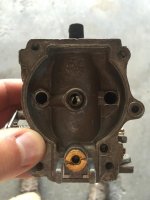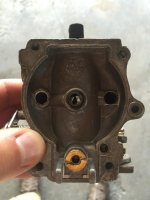This was my grandpa's boat, he gave it to me when he passed. It is in really great shape and was hardly ever used, just sat in the garage. The engine sputters at idle and off idle, it sometimes puffs back out the carb. It runs really rough. It also idles real slow. I have checked the reeds, rebuilt the carburetor, new spark plugs, wires and ignition coils, water pump and lower unit seals, new fuel tank and fuel line, rebuilt fuel pump. Both cylinders are getting spark. Compression on both cylinders is 125 psi. I have the idle screw on the carb set at 1 1/4 turns out from all the way closed. I also have the little white screw you see at the end of the video turned all the way in. I have not driven the boat on the water yet. Sorry if the video is sideways, I didn't flip my phone while filming. It makes the one noise/sputter around 2:20.
I have also taken off the throttle cable, adjusted the white plastic screw all the way in and then adjusted the throttle cable out to match. Still having the same issue.
I have also taken off the throttle cable, adjusted the white plastic screw all the way in and then adjusted the throttle cable out to match. Still having the same issue.







